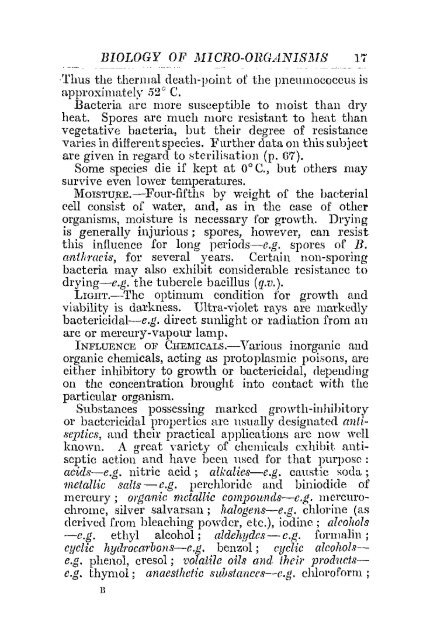AGf~ICULTURAL RESEARCH, PUSA.
AGf~ICULTURAL RESEARCH, PUSA.
AGf~ICULTURAL RESEARCH, PUSA.
You also want an ePaper? Increase the reach of your titles
YUMPU automatically turns print PDFs into web optimized ePapers that Google loves.
BIOLOGY OF 1HICRO-OIWANIS1I1S 17<br />
-Thus the thermal death-point of the 11llenlllococcWi is<br />
apPl'oximate(',; 52° C.<br />
Bacteria are more snsceptible to moist than dry<br />
heat. Spores are much morc resistant to heat than<br />
vegetative bacteria, but their degree of resistance<br />
varies in diHerent species. l"urthel' data all this subject<br />
are given in regard to sterilisation (p. (7).<br />
Some species die if kept at 0° C., but others may<br />
survive even lower temperatures.<br />
MOISTU.RE.-Four-fifths by weight of the baderial<br />
cell consist of water, and, as in the case of other<br />
organisms, moisture is necessary for growth. Drying<br />
is generally injurious; spores, however, can resist<br />
this influence for long periods-e.g. spores of B.<br />
antlimcis, for several years. Certain non-sporing<br />
bacteria may also exhibit considerable resistance to<br />
drying-c.g. the tubercle bacillus (q.11.).<br />
LIGHT.-Thc optimum condition for growth and<br />
viability is darkness. Ultra-violet rays are markedly<br />
bactericidal-e.g. direct sunlight or radiation from an<br />
arc or mercury-vapour lamp.<br />
INFLUENCE OF CHEMICALS.-Various inorganic and<br />
organic chemicals, acting as protoplasmic poisons, are<br />
either inhibitory to growth or bactericidal, depending<br />
on thc concentration brought into contact with the<br />
particular organism.<br />
Substances possessing markcd growth-inhihitory<br />
or bactcricidal properties aTC llsually designated antiseptics,<br />
and their practical applications are now well<br />
lmmvn. A great variety of chemicals exhibit antiseptic<br />
action and have been llsed for that purpose:<br />
acids-e.g. nitric acid; alkalies-c.g. caustic soda;<br />
metallic salts - c.g. perchloridc and biniodide of<br />
mercury; organic mctallic compounds-c.g. mercurochrome,<br />
silver salvarsan; halogens-e.g. chlorine (as<br />
dcrived from bleaching powder, etc.), iodine; alcohols<br />
-e.g. ethyl alcohol; aldehydcs-e.{!,. formalin;<br />
eycNc hydJ'OwTbons-e.g. benzol; cyclic alcoholse.g.<br />
phenol, cresol; volatile oils and thei!' p!'od'llctse.g.<br />
thymol; anaesthctic sllbsfances--c.g. chloroform;<br />
n

















